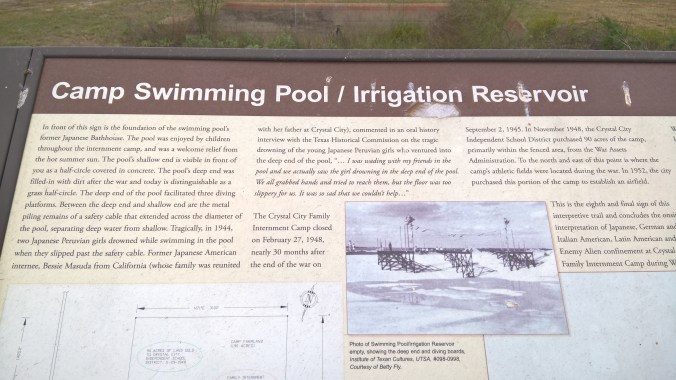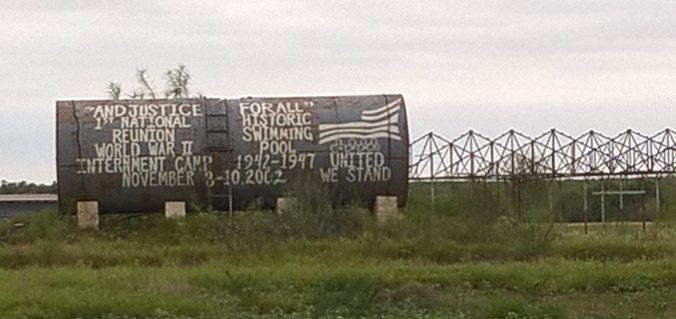
Here is a quote from the jacket of the book, The Train to Crystal City by Jan Jarboe Russell.
“From 1942 to 1945, secret government trains regularly delivered civilians from the United States and Latin America to Crystal City, a small desert town at the southern tip of Texas. The trains carried Japanese, German and Italian immigrants and their American-born children. The vast majority were deeply loyal to the United States, were never charged with any crime, and did not understand why they had been forced to leave their homes.
The only family internment camp during World War II, Crystal City was the center of a government prisoner exchange program. During the war, hundreds of prisoners in Crystal City, including their children, were exchanged for other ostensibly more important Americans – diplomats, businessmen, soldiers, physicians and missionaries – behind enemy lines in Japan and Germany.”
Growing up in South Texas about one hundred miles from Crystal City, I had visited this small town with my parents but never knew that it had been home to an internment camp that some called a concentration camp.
Those internment camps for the Japanese got more attention in the history books. These immigrants had committed no crime but were still detained and held behind a 10-foot high fence as if they were prisoners. In time it came to resemble a small town with stores, churches, schools, libraries, a hospital and a swimming pool. Families lived in small one-family cottages. While the detainees were treated well, they were still the equivalent of prisoners.
Russell interviewed more than fifty survivors and gained access to private journals, diaries, FBI files, camp administration records and more. Through her research she follows the camp from opening to closing and provides detailed descriptions of daily life in the camp. One focus was on two American-born teenagers, one Japanese and one German, and how they were affected by the camp, their repatriation to Japan and Germany and finally the choice they made to return to the United States.
During the war some were released, paroled or repatriated; others were kept for the duration of the war. The camp was finally closed in 1946.
The author has also written a biography, Lady Bird: A Biography of Mrs. Johnson.
—————————————————
After I learned of this little known part of the history of WWII and the part this remote Texas town played in the drama, I wanted to visit Crystal City again after all these years. Husband and I drove to Crystal City one cold November day and on our way passed through the small Texas town of Freer where I grew up. The first stop was in Crystal City at the Popeye statue; more people probably know that the city claims to be the Spinach Capital of the World than that there was once a camp for alien enemies outside of town.
Since the former camp is not exactly a tourist attraction, we stopped at the local library to ask directions. A young woman gave us directions and informed us that there was not much to see but there there some markers. We followed the directions toward the edge of town and passed several public school campuses. The pavement ended and we were on a dirt road.

The area was marked by these simple wooden information signs describing the site; I had expected something more than these humble, almost reluctant, reminders of history. Although we did not find it that day (it was cold!), there is a stone marker that reads, “World War II Concentration Camp 1943-1946” installed in 1985. In 2014 the site was listed on the National Register of Historic Places. Wikipedia has a photo of the stone memorial and more information.

A marker with a “you are here” on a map of the former camp. Note that it was described as “American Enemy Alien Internment” while photos appear to more like people at a summer camp enjoying swimming, diving and other activities.

Description of the reservoir that was converted into a swimming pool.

This seemed to be a tank used to mark a reunion of survivors of the camp and the site of the swimming pool.

The area is quiet today with nothing but a few foundations to remind us of what had been outside this small Texas town south of San Antonio. It is rough flat country with heat and sun and dust, just miles from the border of Mexico. What must have those families have thought when they arrived? How did they face the unknown with no control over their fate? How did they feel about the government of the United States?
There are lessons to be learned from this period even today as the loyalty and patriotism of some immigrants is sometimes questioned. We saw the reaction when we were attacked on 9/11. Some of that fear still lingers.
Related books:
The Crystal City Story: One Family’s Experience with the World War II Japanese Internment Camps by Tomo Izumi (non-fiction written by a survivor of the camp)
The Last Year of the War by Susan Meissner (historical fiction)